How do you hold a moonbeam in your hand? Third Wall Productions will show you how with their stellar production of Rogers & Hammerstein’s The Sound of Music. Having changed venues again, to what is hopefully now their theatrical-forever-home, the hard-working community theatre brings its 2023 stage productions to the stage & hall of Chestnut Grove Presbyterian, and is settling into the space a bit like Maria Rainer is settling into the von Trapp household, in their own wonderfully whirling dervish sort of way. Directed by the company’s new artistic director, Kristen Cooley, with Musical Direction by William Zellhofer and Choreography by Mea Holloway, this time-cherished musical theatre staple is a delight to watch.
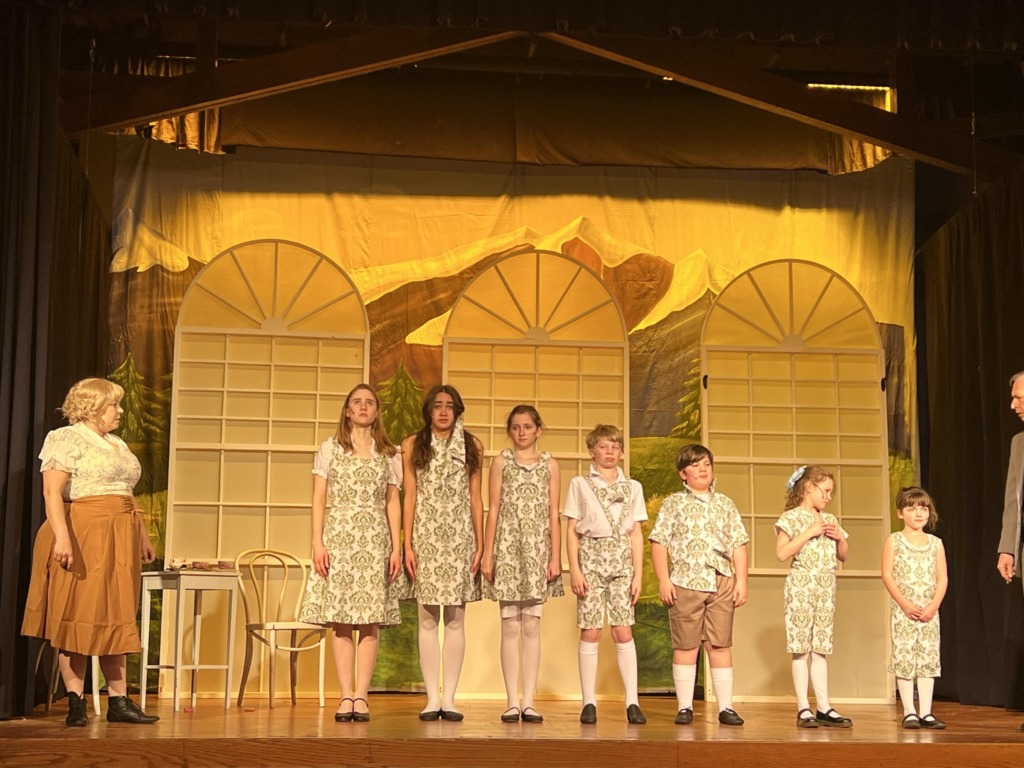
Set Designer Pat Rudai brings together both a functional and fashionable set, creating a vivacious and lively atmosphere for what can all too often feel like a stale musical. Rudai crafts the interior of the abbey and the interior of Georg von Trapp’s house notably different from one another without compromising the pace of scene changes. The walls of the audience-seating-area are flanked with bucolic and verdant painted curtains (which cleverly conceal the live orchestra, conducted and well-balanced by musical director William Zellhofer) which gives the audience a slightly immersive feel for the show. Rudai gives a nod to the company’s Baltimore roots by using the ‘upright-Hairspray-style’ bed for Maria’s room, where all of the children pile in during the storm and gleefully yodel their way through “The Lonely Goatherd” (which features some unique hand-crafted marionettes made by Emma Hawthorne.)
Falling in line with the top-notch scenic work, Costume Team Caitlin Johnston, Amy Rudai, and Grant Myers outfit each player of the production in togs and threads that match their roles respectively. The Sound of Music is more than just bubbly, bouncing youths singing “Do-Re-Mi”, there’s a whole series of nuns, Nazis, and well-heeled party-diners who appear in luxurious evening attire that— while not strictly period appropriate— is elegant enough to be more than acceptable in the eyes of the audience. Johnston, Rudai, and Myers do what (in my opinion) is arguably the most important but often the most overlooked detail-oriented costume-making in this production. They hang curtain fabric in Maria’s bedroom that MATCHES the outfits that the von Trapp wear in the subsequent scene where Maria claims to have made their play-clothes from her old curtains! It’s a curious shade of green and white paisley print but works resplendently when the seven children all tromp out wearing rompers and dresses that legitimately match the curtains. Johnston, Rudai, and Myers deserve pats on the back for all of their well-executed efforts in the show’s overall sartorial selections.
When it comes to sound design… Third Wall Productions is settling into a new venue and addressing the challenges of how the acoustics work in the space, how the masked-orchestra floods into the space from the side, how having body mics on very young children can add a unique flavor to the overall performance (there were absolutely points in the show where the microphones decided that they too wanted to participate in the very scary storm that frightened the children into Maria’s bedroom…so they went boom, Boom, BOOM too!) And as far as Jim Shomo’s lighting design, it may be the first show he’s done with Third Wall where the illuminating effects were practically perfect. Only one set of moving lights (the floods during the Nazi-search scene) and everything else had a balance and simplicity to it that was simply marvelous. (We’ll overlook the awkward jaundice bath that hit the performers during “How Can Love Survive” as the space is still brand new to the production team and figuring out which lights create what colors against certain sets in certain spaces is still very much a learning process.)
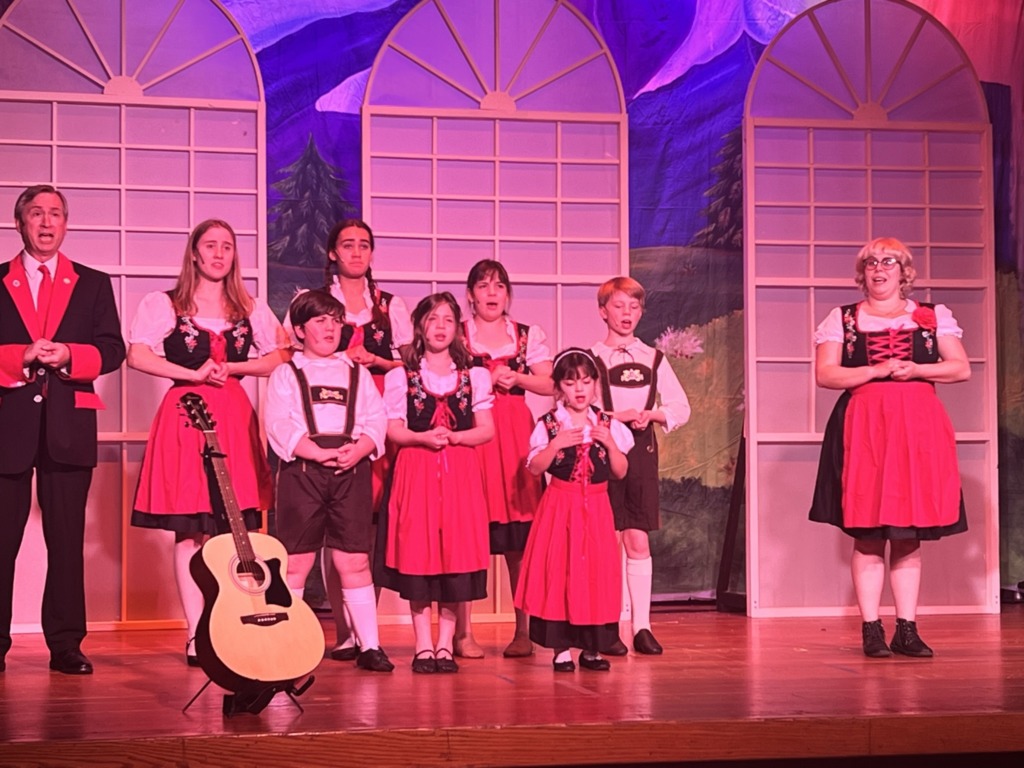
William Zellhofer manages marvels with the community theatre orchestra that played in the pit for this production of The Sound of Music. Working alongside Conductor Ben Fish, the two of them create a solid block of sound that is neither overbearing nor underwhelming. It is no small feat to be off to the side of the stage, practically in the house, and hidden from view by a large scenic curtain and still keep tempo, blend, and balance as impressive as the pair of them do. There were a couple of moments where the music fell out of sync with what was happening on the stage but they were so minor, one could hardly mind.
One doesn’t often think of heavy choreography— or really even any choreography— when it comes to The Sound of Music, at least not in the big, splashy, Broadway-style numbers sense, at any rate. Mea Holloway, who wears the hat of both choreographer and Maria Rainer in this production, brings lively and sprightly dance moves, however subtle, to a great many numbers. Even at the top of the performance, once the nuns have processed through the main aisle of the audience and up onto the stage singing “Preludium”, Holloway has them window-box-stepping in and out of line with one another, which creates this slightly hypnotic quality and feels a little like you’re watching a gentle cuckoo-clock filled with nuns popping out to announce the time for vespers. The adorable little dance shared between Liesl and Rolf as well as the bouncing bubbly movements of the children during “Do-Re-Mi” is on point for the type of dancing that often accompanies this particular Rogers & Hammerstein.
Director Kristen Cooley’s efforts with this production have paid off tenfold. The pacing is precise, which is important in these more dated musicals as they tend to err on the lengthier side of existence. (Different times, as they say.) And Cooley’s casting is an equal balance of seasoned veterans and youthful youngsters alike. There’s even a German Shepherd (Jager Zellhofer, quite possibly making his stage debut) that accompanies the Nazis on the hunt near the show’s conclusion. Of course, floofy sweet Jager is a sharp contrast to the mean and terrifying Herr Zeller (Bryan Brown) who readily puts the fear and menace of Nazism straight into the show the minute he arrives on stage in the role. Cooley works wonders with the cast to really highlight the story. Beautiful and iconic music is one thing but if the story that carries these songs gets lost in the pretty melodies and harmonies, what’s the point? Cooley makes sure that the audience feels the point. The children are playful in earnest, the ever-looming cloud of potential invasion creeps in subtly and becomes more heavy-handed the further on the production advances.
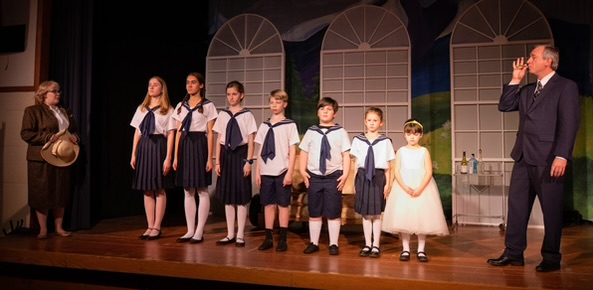
Some of Cooley’s finest work is in her character-building and relationship dynamic construction among the principal characters. Transforming the loveable and affable Paul Ballard into an ferocious force to be reckoned with, Cooley guides Ballard through the process of Georg von Trapp from his militaristic beginnings through to his proud and determined endings. And the chemistry that Cooley encourages between Ballard’s Georg and Mea Holloway’s Maria is palpable, believable, and endearing. Cooley’s focus for this production seems to be completed character arcs, marking the nuanced developments of under utilized characters like Frau Schmidt (played by Jessica Preactor with rigorous deadpan and staunch liveliness checked only by the character’s station) and Rolf (played by Andy Collins whose voice is superb for “Sixteen Going on Seventeen.”) You see his transition most readily in Cooley’s work, and it isn’t just a light-switch from gooey-eyed male ingenue to hardened Nazi; it’s a progression, which is astonishing considering the character is given such little stage time.
The gaggle of named nuns (Joan D’Adamo, Christina Blackman, Alex Clasing as Sisters Margaretta, Berthe and Sophia, respectively) lend their airy gospel voices to “How Do You Solve a Problem Like Maria?” with great spirits. They are boisterous, which is a nice change from their otherwise cloistered lives and during the “suitcase-pre-wedding” moment the looks of shock and embarrassment are quite humorous. Mother Abbess (Nancy Williams-Nettles) has a voice like no other. The operatic high-belt that she pours into the end of “Climb Ev’ry Mountain” will bring you near to tears. The fulfilling and deeply satisfying sounds that Williams-Nettles delivers with her singing is almost enough to overlook her unusually aloof character portrayal when seated at her desk in the abbey office. Some of her exchanges with Maria feel stifled, almost as if they were a reading exchange but all of that is easily forgiven and forgotten when you hear her sing.
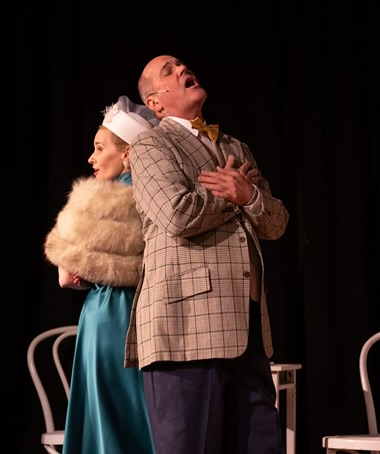
Making for a well-grounded delight, though the character itself is nothing anyone wants to love as nobody loves the splinter between Maria and Georg von Trapp, is the radiant Elsa Schrader (on special contract from Actor’s Equity Association, Sharen Becker.) You’d swear Becker was air-lifted from the late 1930’s and placed down in the middle of the stage. Airs and graces, though far from haughty, scream from that era, even the way she carries her figure around the stage lends itself to a woman from a long-ago time. Becker has a lovely voice, light and melodious, perfectly suited for “How Can Love Survive?” and “No Way to Stop It.” Both of these songs are sung with Max Detweiler (Bill Bisbee) and with or around George.
Bill Bisbee as the charming and flighty, self-serving ‘uncle Max’ to the von Trapp children, is a delicate layer of comedy gently draped over the darkness that creeps into the production. With his mincing, affected walk, the quirky way he phrases certain words, you’ll find plenty of humor to be had with Bisbee’s portrayal of Max. And his warm and welcoming voice makes digesting the messages beneath “How Can Love Survive?” as well as “No Way to Stop It” much easier on the brain. His comic timing is sharp and a great many of his punchline-zingers land with quite a zip.
The adorable, sensational seven von Trapp children— Liesl, Louisa, Brigitta, Friedrich, Marta, Kurt, and Gretl (at this performance— Natalie Russell, Amelia Blackman, Jane Swanson, Aleksander Graff, Wilhelmenia Volk, Patrick Rudai, Caroline Swanson)— are precious, precocious, and have learned to harmonize beautifully. Both renditions of “So Long, Farewell” are dulcet and delightful to watch. Amelia Blackman, as Louisa has quite the time pulling faces as the more obstreperous of the children and you won’t be able to keep your eyes off of Caroline Swanson, the youngest in the bunch.
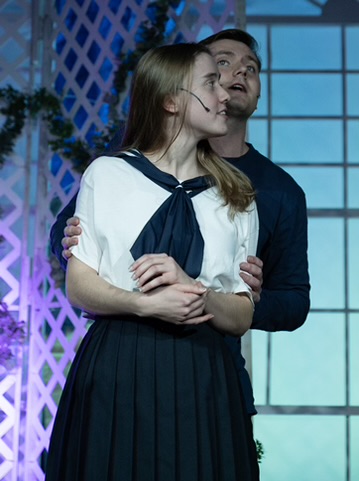
Natalie Russell, as Liesl has a fantastic moment— really most of the song— during “Do-Re-Mi” where she sets pouting on the couch, refusing to partake in the childish nonsense that the new governess has introduced to the children. But watch her (if you can tear your eyes away from all the fun the other children are having) as she struggles to control her mixed feelings. It grows clearer and clearer with every passing moment of the song just how much fun the Liesl character thinks it is but she’s too stubborn to admit that she might not be too old for a governess after all. It’s a brilliant. Choice. Russel’s onstage relationship with Maria is genuine and touching. Particularly when they sing “Sixteen Going on Seventeen (Reprise)” together. Russel has a genuine flare for the stage, her voice alights on both versions of “Sixteen Going on Seventeen” in two different veins, showcasing her performing versatility as well as her singing capabilities.
Paul Ballard’s Captain Georg von Trapp is remarkably versatile and surprisingly dynamic. There is almost a sinister hardness to him when he is first introduced to Maria Rainer, almost like an artic icy shell, which then slowly melts away as the characters continue to interact and grow together. One of the most astonishing and truly touching moments occurs when Ballard’s hands his whistle to Maria in a moment of pure understanding; he no longer needs it because she has healed his heart and made his life whole again; an utterly remarkable and yet beautifully subtle moment. Ballard’s voice is smooth and rich, perfect for “The Sound of Music” and “Edelweiss”. The transformation Ballard brings to the character over the course of the evening is truly stunning.
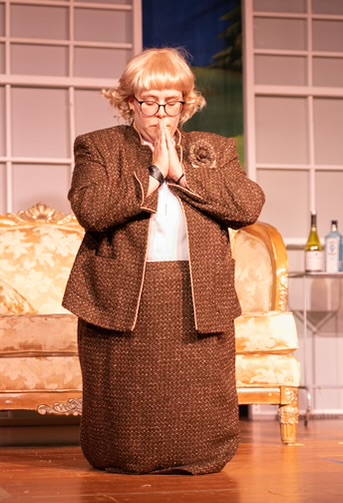
As for Maria, Mea Holloway is serving up textbook Julie Andrews with that indefatigable hope, faith, and determination. There’s an uncrushable joy, an unyielding glee— even in the dark and troublesome moments which permeates her presence every time she’s on the stage. With a voice that gives the character its due, songs like “My Favorite Things” and “The Sound of Music” drift fondly to the audiences’ ears, carried on the melodic nostalgia of Holloway’s voice. Watch her sharp and snarky side though. It only rears its head once— very specifically and dismissively— when casually stating to Elsa Schrader, “I’ll pray for you.” The way Holloway interacts with the children, with Mother Abbess, and especially with von Trapp comes from a believable place of earnest love and happiness and it is refreshing to see such a performance on stage at the community level.
Like the children sing, ‘…so long, farewell, auf weidersehen, goodbye…” don’t wait for tickets, or else away they’ll fly! It is a truly impressive production as Third Wall Productions settles into their new home at Chestnut Grove Presbyterian Church.
Running Time: Approximately 3 hours with one intermission
The Sound of Music plays through January 22, 2023 with Third Wall Productions, now in residence at Chestnut Grove Presbyterian Church— 3701 Sweet Air Road in Phoenix, MD. Tickets are available by at the door or in advance online.
